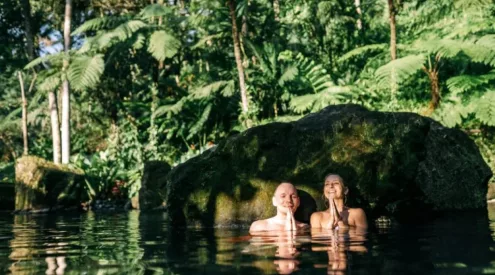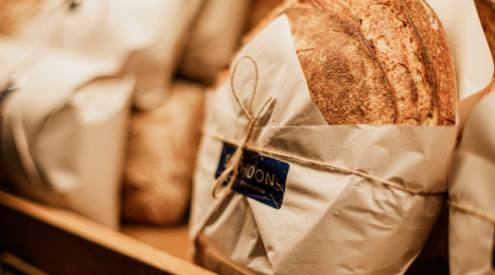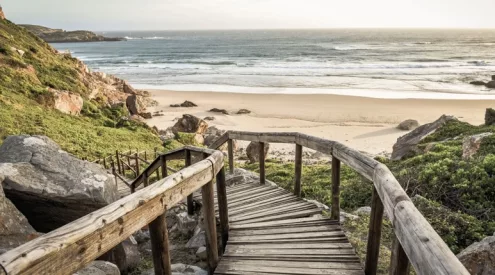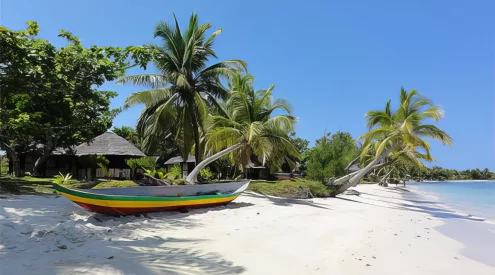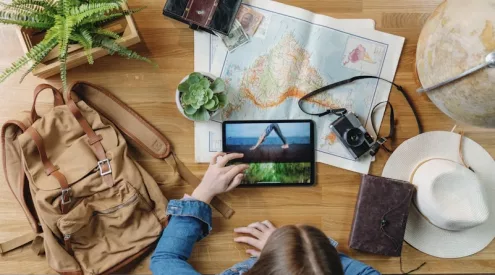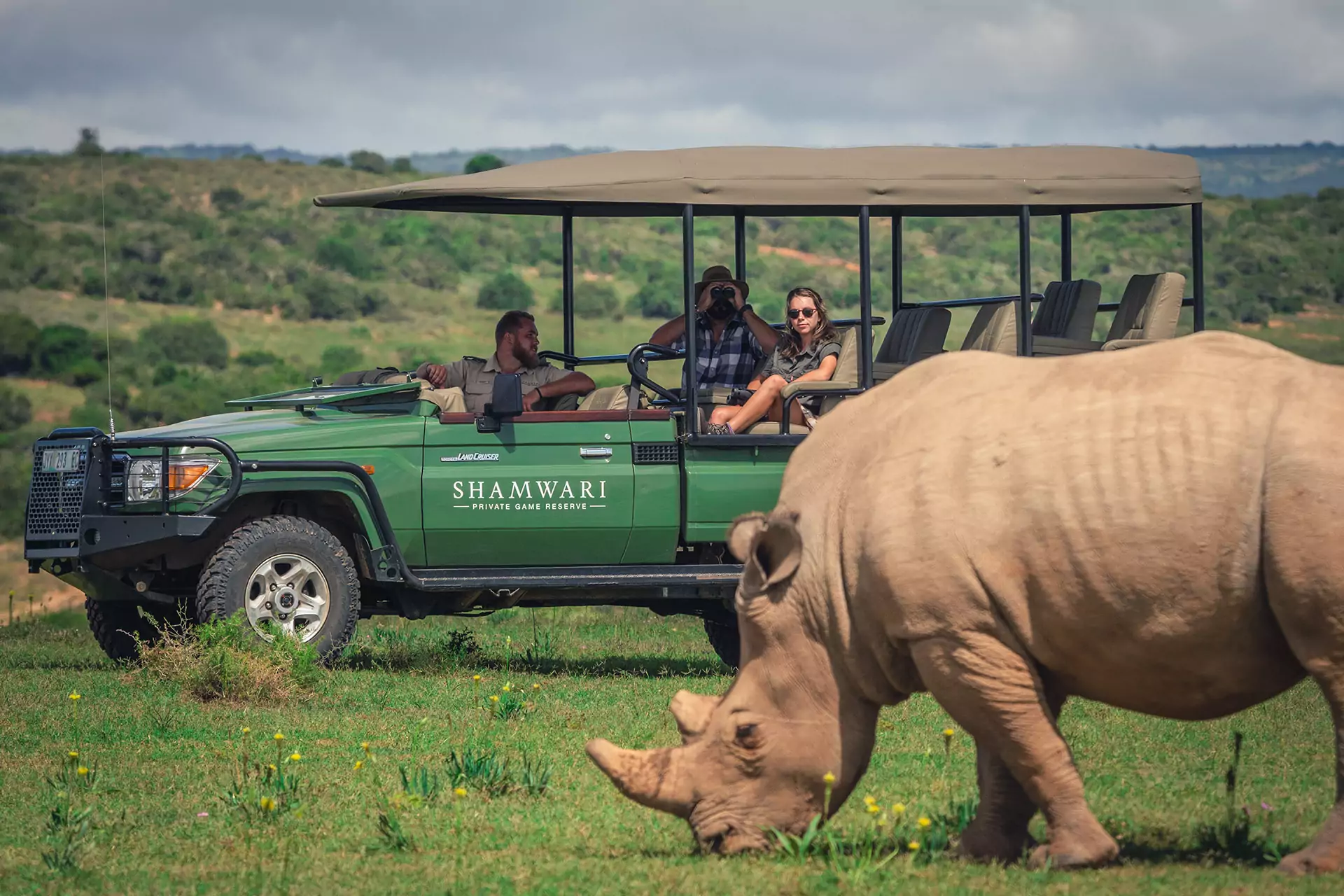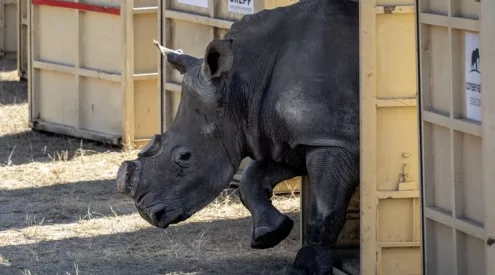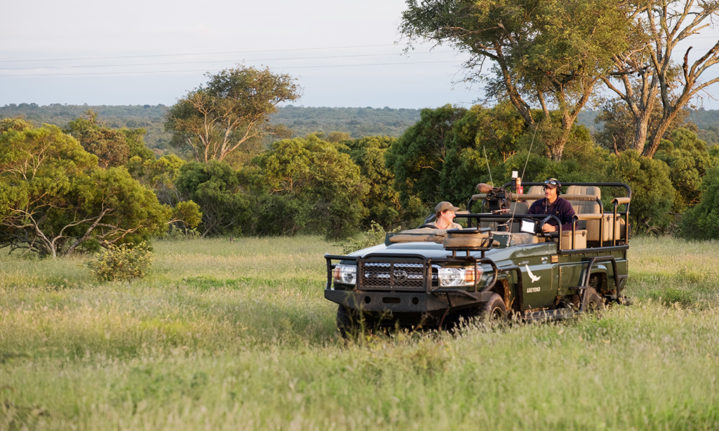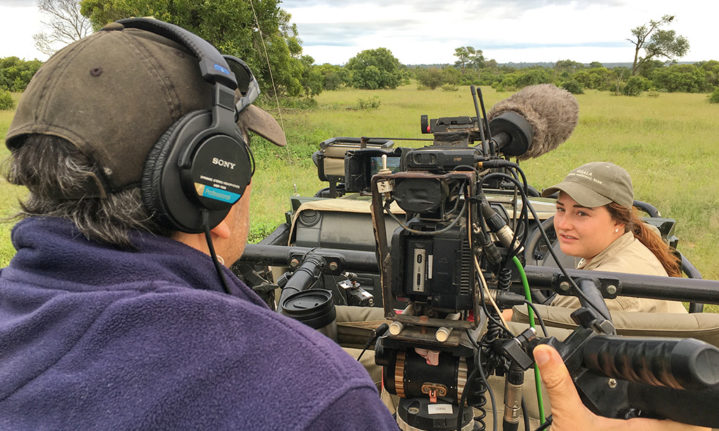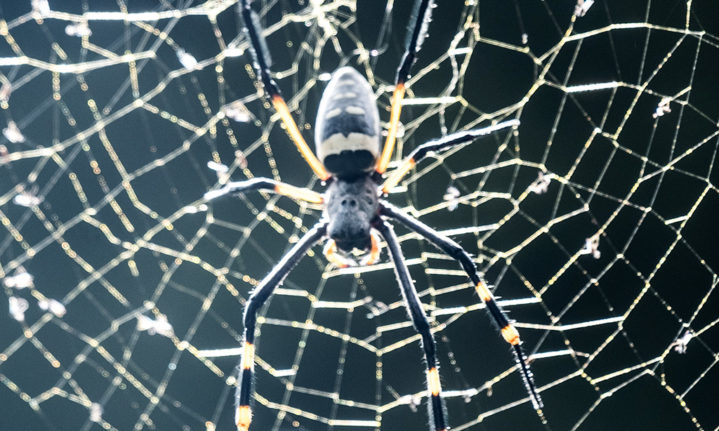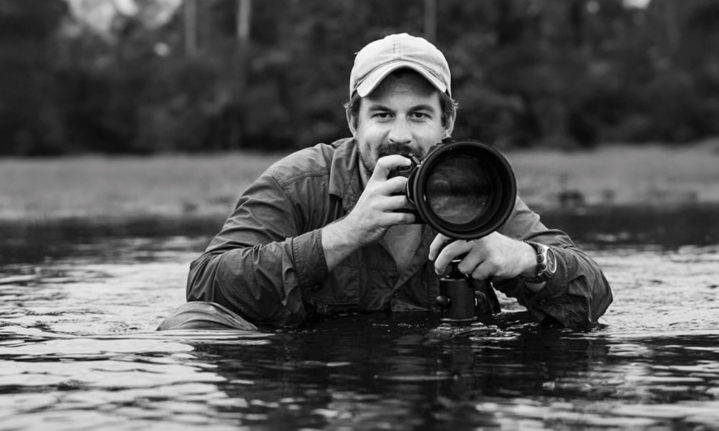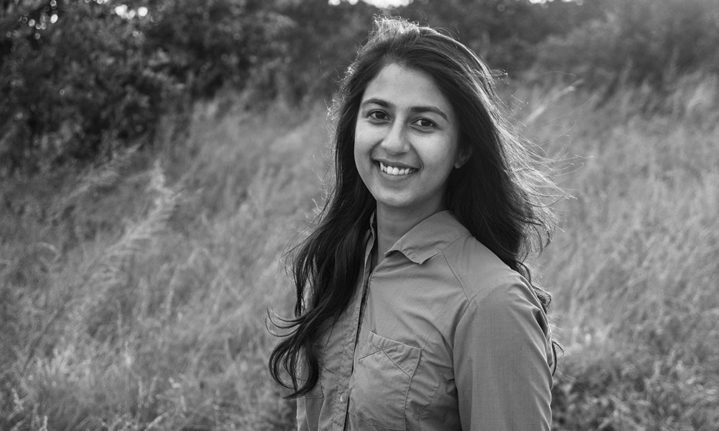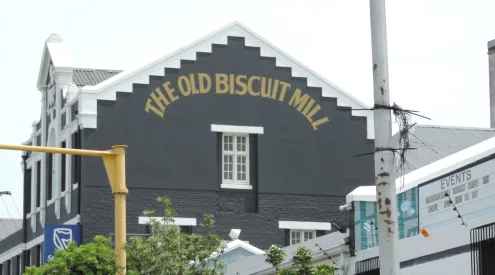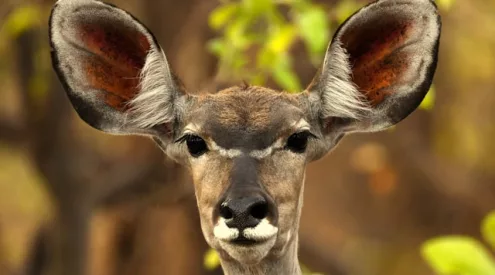Every month, more than a million people around the world have been clicking onto the WildEarth channels, desperate to experience the magic of the African bush. Curious to know what goes on behind the scenes, Narina Exelby hopped into a vehicle for a sunset drive with the WildEarth crew.

Amera operator Sebastien Rombi and naturalist Tessa Woolgar, bringing the magic of the bush into living rooms across the globe.
It’s late afternoon – hot at the end of summer – and all across the Lowveld, safari vehicles are leaving camps, searching for surprises the bush might have in store. While many amble along, with guides and trackers leaning out to read the tracks, one – driven by &Beyond Ngala guide Tessa Woollgar – is moving with a sense of purpose. ‘We’re going to check on the wounded blonde Ross male,’ she says, shifting gear. ‘We spent time with him this morning; the viewers were very concerned.’
As well as a guide at Ngala, Tessa is a naturalist for WildEarth, a channel that livestreams game drives from five wildlife reserves around South Africa. Twice a day, unscripted three-hour drives are broadcast from the bush – and over the course of a month, more than one million viewers in 150 countries will watch from the comfort of their homes.
Earlier this morning, Tessa and camera operator
Sebastien Rombi came across the injured lion during their sunrise broadcast. As Seb zoomed in on the gash on the lion’s forehead, sympathy flooded into the comments boxes of WildEarth’s YouTube and Facebook pages: ‘Ouch! Oh my – look at that wound! Poor boy. Oh my goodness! Claw or tooth puncture? Looks horrible!’
‘There have been a lot of lionesses in the area,’ one viewer wrote, assessing the situation. ‘The fight could have been over a lioness.’
It’s easy for Tessa to find the lion – he’s exactly where she’d left him earlier, and as she sidles the vehicle closer she muses, ‘It’s incredible how loyal the viewers are. They love getting to know the animals, learning their behaviour and dynamics – and they form real attachments to the cats, especially.’
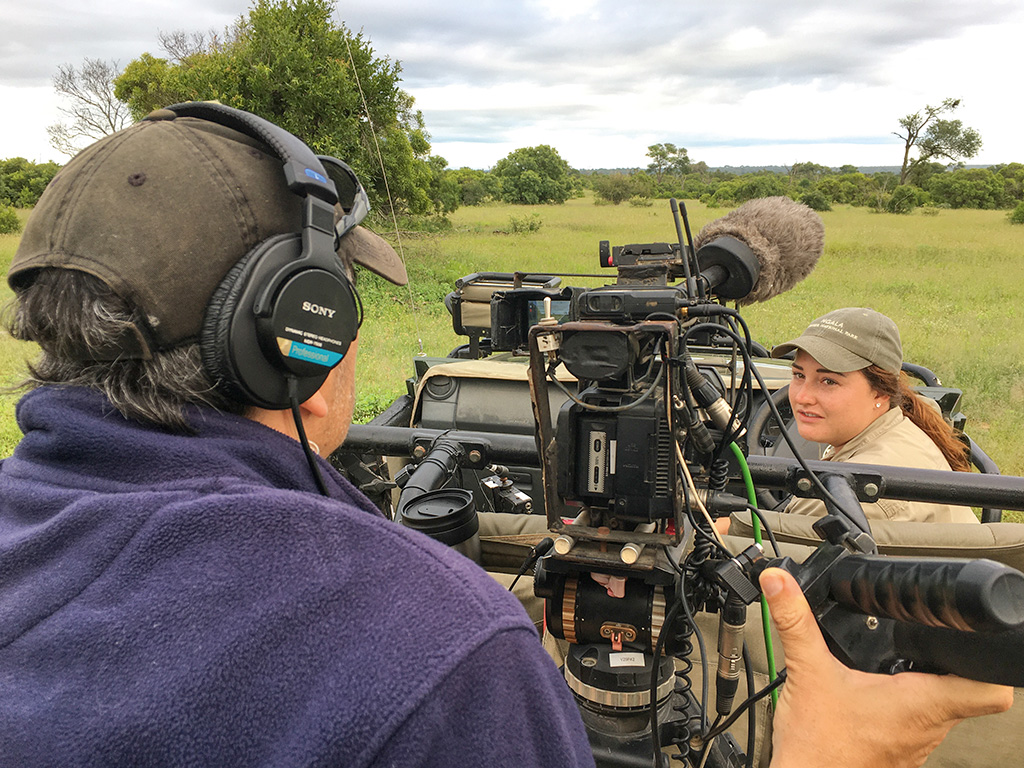
The WildEarth cameras are always fixed and positioned just behind the naturalist – which gives the impression the viewer is in the vehicle on the game drive.
Tessa’s not on air yet. Via the earpieces they wear throughout the drive, Tessa and Seb have been informed by Jarrett Mukheibir, one of the show’s directors in the Johannesburg studio, that the current live segment is on a leopard at &Beyond Phinda. ‘We can’t hear what’s being broadcast, but the director keeps us informed with who’s live and what animal they’re with. When we go live, the director feeds me any relevant questions and comments from viewers so that I can respond in real time.’
It’s this interaction that viewers love; it makes them feel an integral part of the drive, and it’s helped to build a loyal and tight-knit online community. ‘When I go into WildEarth’s live chat there are specific people I’ll always have a conversation with,’ Jen Rast, a WildEarth follower from Australia, told me as we chatted – in person – over breakfast at &Beyond Ngala Tented Camp. ‘The connection that people have with each other is a big part of what we all love about the channel.’
‘This trip has been emotional and surreal,’ Jen said as hot croissants arrived from Ngala’s kitchen. ‘I’ll always cherish the moment I saw my first lion in real life. He was one of the Ross males, sitting there looking so regal; even his mane was blowing in the wind.’
The lion Jen mentioned is the brother of the injured one we’re watching now – and it was quite likely he who caused the gash on this lion’s forehead. Tessa positions the vehicle so that Seb can catch the best view of him, then watches the screen mounted on the passenger seat as Seb zooms in on the wound. ‘See how it’s starting to scab up around the edges? It’s looking better than it did this morning,’ she says, watching the same footage viewers would see if she were broadcasting live. ‘The viewers will be relieved.’
Seb holds a hand to his ear, listening to the voice in his earpiece. ‘Signal’s not going through,’ he says. The lion barely raises his head as Tessa repositions the vehicle; a few moments pass. Seb checks the WildEarth WhatsApp group. ‘They can’t hear us,’ he says. Seb reboots his equipment. Tessa repositions the vehicle again, then again. Still no signal.
‘Getting signal out here is not an exact science – we had a great connection right here this morning,’ shrugs Gabon-born Seb, who has filmed around Africa for 10 years for the likes of National Geographic, and who’s worked for WildEarth for five years. ‘We tend to have better signal in the winter. The dense bush in the summer really hampers our connection – even though we have four connections to two service providers.’
Finding a signal isn’t the only technical challenge while broadcasting from the bush. The gear works hard – six hours a day, out in the elements – and then there are the spiders that lay eggs in the wiring; elephants that dig up the cables at the popular Dam Cam webcam; monkeys that pull wires down.
The wounded lion would make an excellent segment but, Tessa and Seb agree, they’ve been here long enough. ‘We need to contribute to the show,’ Seb shrugs. ‘It’s time to move on.’
Can they not just film this lion now, send it to the studio when they find signal and slip it into the broadcast? ‘Definitely not,’ Tessa feigns horror at my suggestion. ‘There’s always something special to see in the bush, whether it’s a golden orb spider in the early morning light, or a bird of prey, or an elephant with her calf. Every broadcast we do is live and completely wild – and that’s the magic of it.’
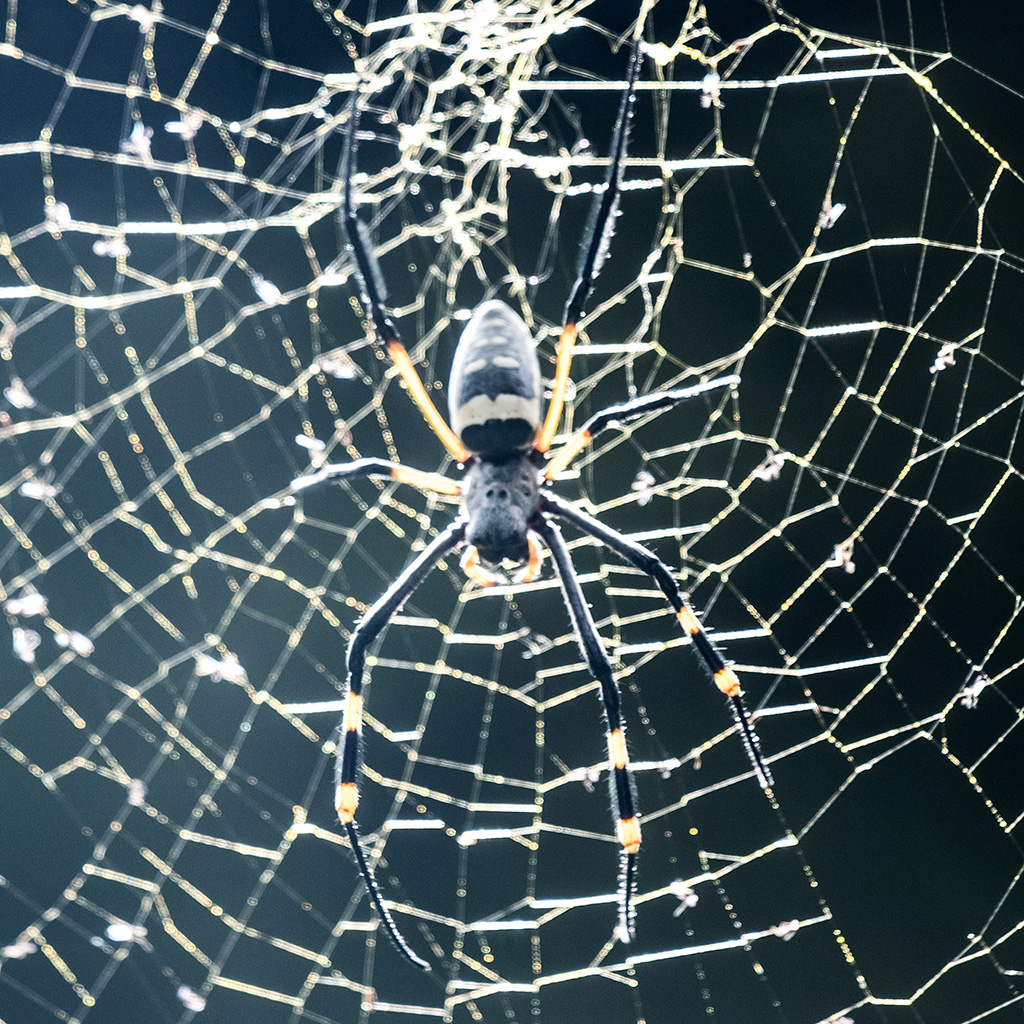
What’s next for WildEarth?
A vision of WildEarth founders Emily and Graham Wallington has always been to connect people with nature and instill the importance of nature worldover. With their combined experience in TV and the internet (Emily produced wildlife documentaries for BBC and Graham set up Africam) and the help of partner and shareholder Peter Braat, the couple has created a channel that, since 2006, has succeeded in doing just that… but it hasn’t always been easy.
‘When we started out, traditional TV broadcasters told us our content was too boring – but that has changed now,’ says Emily. ‘People really enjoy this kind of escape. We have so much feedback from people on how the broadcasts help them to stay present, how it helps with stress.’
Discussions are now underway for WildEarth to be shown on TV channels in the Middle East, Finland and France (with safaris dubbed into French in real time). ‘We’ve also started the Explorers Programme,’ says Emily. ‘With this, viewers sign up to become a WildEarth Explorer and get various benefits, including live fireside chats with the guides and opportunities to win prizes from our partner locations.’
Faces you might know
Tristan Dicks,
Naturalist
Known for his passion for leopards, Tristan has been presenting on WildEarth for four years. ‘I’m generally a very quiet and shy person, so initially I was petrified of doing live presenter guiding,’ he admits. ‘Luckily those fears have dissipated, and having the opportunity to explore the wilderness and share it with a greater, like-minded community is incredibly rewarding.’

Trishala Naidu,
Naturalist
Trishala – who says she’s a ‘super nerd who’s super curious’ – moved from Durban to Melbourne when she was 12 but returned to South Africa ‘because I had always been in love with the country and its natural environment. Science and understanding the natural world has always bought me such joy – and working on WildEarth has shown me how my knowledge and curiosity can enrich other peoples’ lives.’
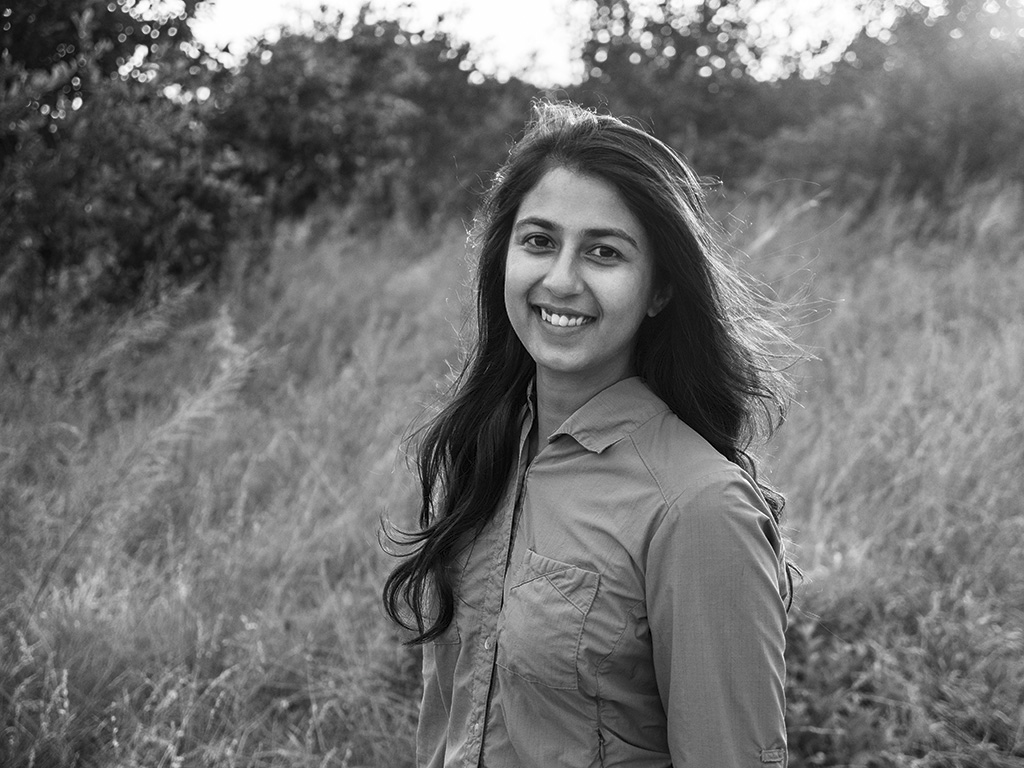
B’kay Uhuru,
Camera Operator
Since he joined the WildEarth team two years ago, B’kay says, ‘my love for nature has grown and grown, to a point where people tell me that I’ve changed. My perspective on life has changed, and I have learnt the importance of nature and the role it plays in our life; how it balances itself, and how animals interact with each other.’
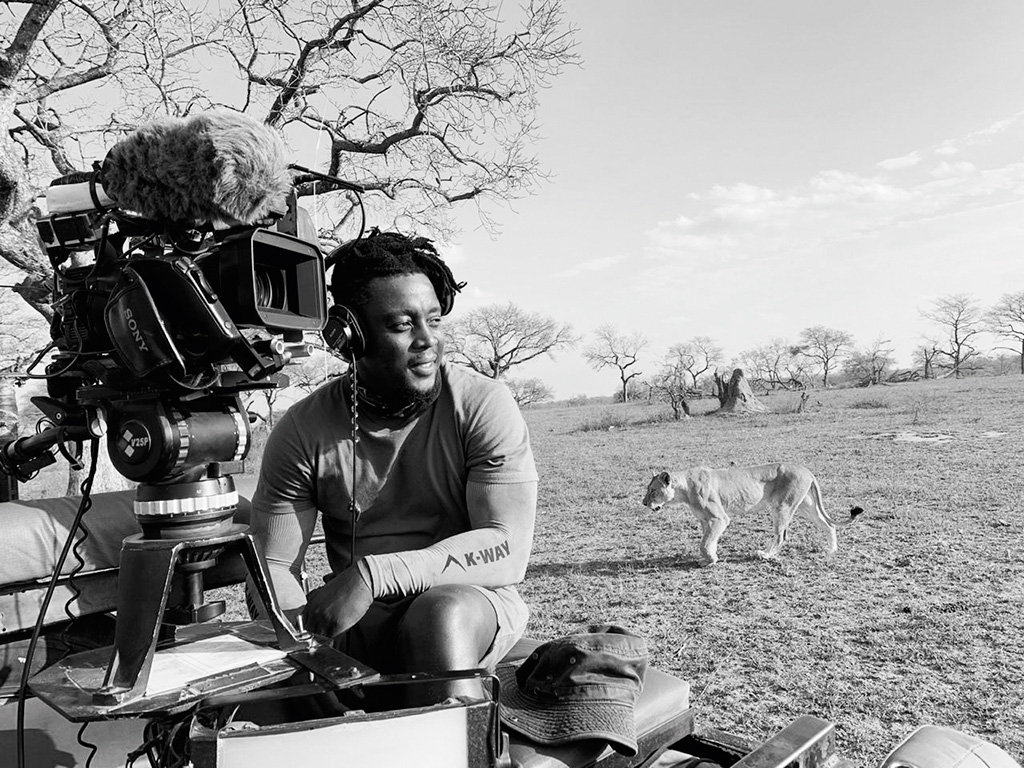
What the fans say
Beverly Williams,
Lebanon, Oregon, USA
I have severe anxiety and depression, as well as a brain tumour, and watching WildEarth has helped me relax so I can sleep. It also helps with my depression and I have fewer seizures. It’s given me a bonding opportunity with the animals; watching them grow and move on with their lives gives me a purpose to continue my life and not give up.
Jen Rast,
Melbourne, Australia
WildEarth has really helped me understand more about biodiversity and the role each living thing plays.
Jackie Boshoff,
Centurion, Pretoria
The first thing I do every morning is turn on the TVto watch the sunrise drive, and I watch again in the afternoon while I’m preparing supper. It kept me entertained during Lockdown – I’m fascinated by the Djuma Clan and I love the dynamics and family trees of the leopards of Djuma and surroundings.
Steven Chinhoi,
Kariba, Zimbabwe
My whole family is hooked on WildEarth. I’m a safari guide so I never get tired of watching wildlife and I really appreciate how they feature experts on different subjects, for example grasses.

